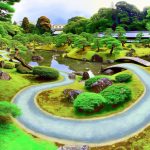Kenrokuen Garden: A Historic Stroll in Kanazawa
Kenrokuen Garden, crafted in the historical context of the 17th century by the influential Maeda family, is nestled in Kanazawa, Japan. It is recognized as one of Japan’s most exquisite gardens. This meticulously planned space provides a genuine reflection of the Edo-period landscape design, capturing the essence and cultural richness of the era. As one of the three great gardens of Japan, Kenrokuen holds its esteemed status due to its intricate design and aesthetic harmony.
Major Features of Kenrokuen
Situated in the heart of Kanazawa, Kenrokuen is a remarkable illustration of Japanese garden architecture. The name “Kenrokuen” itself translates to “Six Attributes Garden,” a nomenclature that sets the stage for what one can expect within its boundaries. It gracefully incorporates the six traditional attributes believed to constitute a perfect garden. These include spaciousness, seclusion, artifice, antiquity, water courses, and panoramic views. This balance of natural allure and human creativity is evident throughout the garden.
Kenrokuen’s design is not merely about beauty but also about creating an atmosphere where visitors can find peace and inspiration. The placement of every tree, shrub, and stone is intentional, contributing to an overall sense of harmony and tranquility that permeates the garden.
Pond and Streams
A defining feature of Kenrokuen Garden is the magnificent Kasumigaike Pond. This large body of water is pivotal to the garden’s aesthetic appeal. The pond is not only a stunning visual element but also serves as a reflective surface that mirrors the surrounding landscape, enhancing the beauty of the scenery. Originating from this pond are meandering streams, skillfully integrated into the garden to enhance its enchanting soundscape and visual allure.
The presence of water elements in Japanese gardens is symbolic, often representing the natural flow of life. In Kenrokuen, the streams and pond play a vital role in maintaining the garden’s ecosystem while enhancing its serene environment.
Seasonal Blossoms
Kenrokuen Garden is a year-round spectacle, showcasing nature’s ever-changing beauty through its seasonal blossoms. In spring, the garden becomes a breathtaking vision as cherry blossoms bloom into vibrant pink corridors. These blossoms attract visitors who wish to experience the traditional Japanese celebration of hanami, or flower viewing.
During the summer months, the garden transforms as lush greenery envelops the space, providing a cool refuge from the heat. The verdant landscape is soothing to the eye and offers a different charm compared to the floral extravagance of spring. As autumn arrives, Kenrokuen is painted in hues of red and orange foliage, creating a warm and inviting atmosphere. Winter, although quieter in terms of visitor numbers, presents its own unique splendor through the technique known as yukitsuri. This fascinating method involves ropes artistically hung in a conical shape from trees to protect them from the heavy snow. The yukitsuri not only serve a practical purpose but also add an artistic element to the winter landscape.
Historic Stone Lanterns and Bridges
Interwoven throughout the garden are historic stone lanterns and bridges, quintessential elements in Japanese garden design. Among these, the renowned Kotojitoro lantern stands out as an iconic symbol of Kenrokuen, often featured in photographs. Distinguished by its two legs, the Kotojitoro lantern is strategically placed to enhance the visual composition of its surroundings. These stone structures are thoughtfully positioned within the landscape, ensuring they complement views and contribute to the garden’s historic appeal.
Bridges, too, play a significant role in Kenrokuen’s design. They not only facilitate seamless movement across the garden but also provide vantage points from which visitors can appreciate the intricate details and broader vistas of the garden. Each bridge is designed to harmonize with its environment, contributing to the garden’s cohesive aesthetic.
Seihotei and Shiguretei Tea Houses
Embedded within Kenrokuen are the Seihotei and Shiguretei Tea Houses, offering visitors an opportunity to delve into Japan’s rich cultural landscape. These traditional tea houses provide a glimpse into the historic tea traditions that are an integral part of Japanese culture. Visitors can participate in tea ceremonies, experiencing the meticulous rituals and customs that have been preserved over centuries.
The tea houses are situated in serene settings, allowing guests to enjoy their tea while gazing out at the tranquil garden landscape. This fusion of cultural experience and natural beauty provides visitors with a deeper understanding of Japanese traditions and the aesthetic sensibilities that underpin Kenrokuen’s design.
Accessibility and Visitor Information
Centrally located in Kanazawa, Kenrokuen is easily reachable by public transportation, making it an accessible destination for both local and international visitors. As a significant attraction in the area, the garden operates from early morning to late afternoon, with extended hours during special events. For those planning a visit, practical details and ticket information can be found on the official Kanazawa Tourism website.
To fully appreciate the garden’s intricate design and historical significance, guided tours are highly recommended. These tours offer detailed insights into the garden’s history, design elements, and cultural context, enriching the visitor experience. Whether explored independently or through a guided tour, Kenrokuen Garden promises a memorable journey into Japan’s botanical artistry and cultural heritage.












